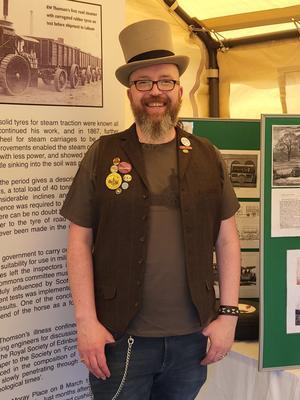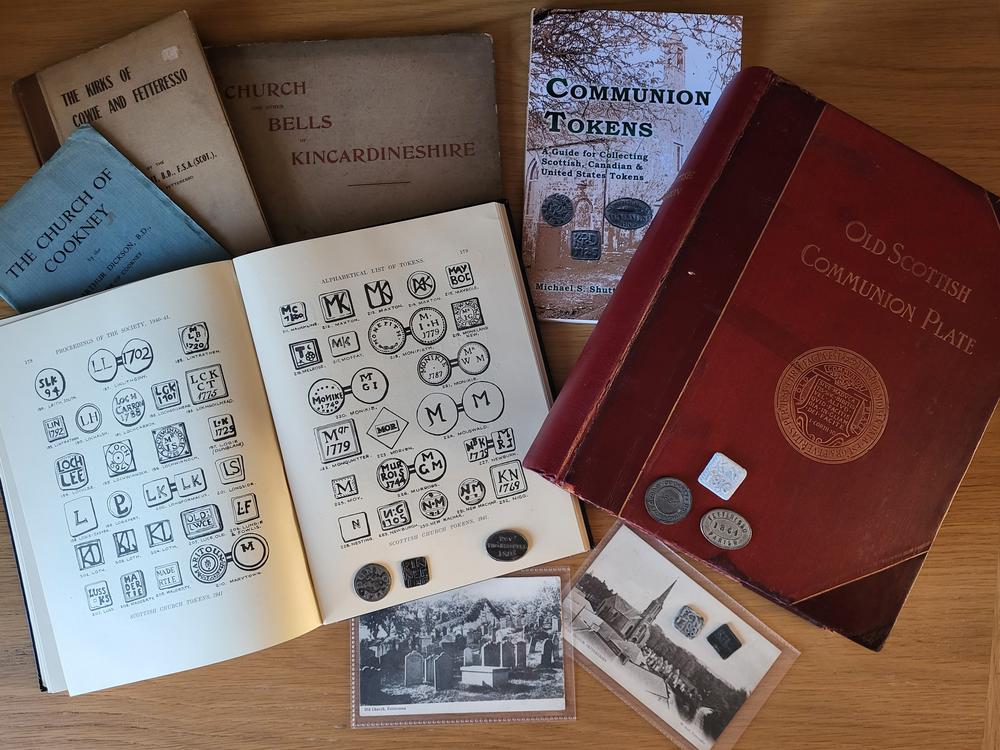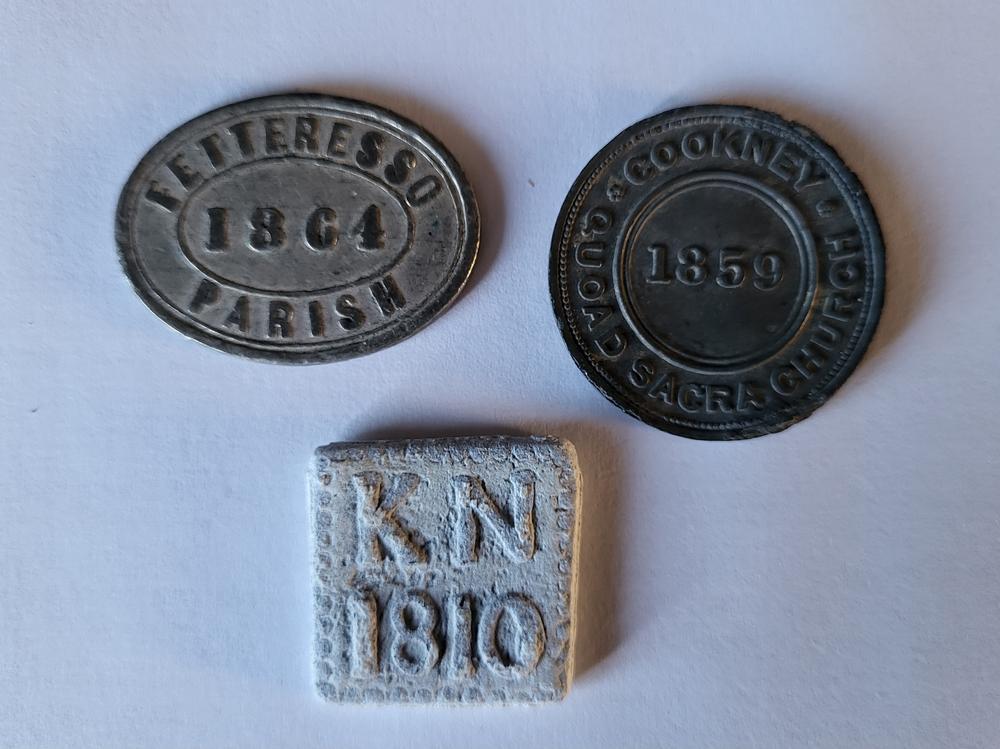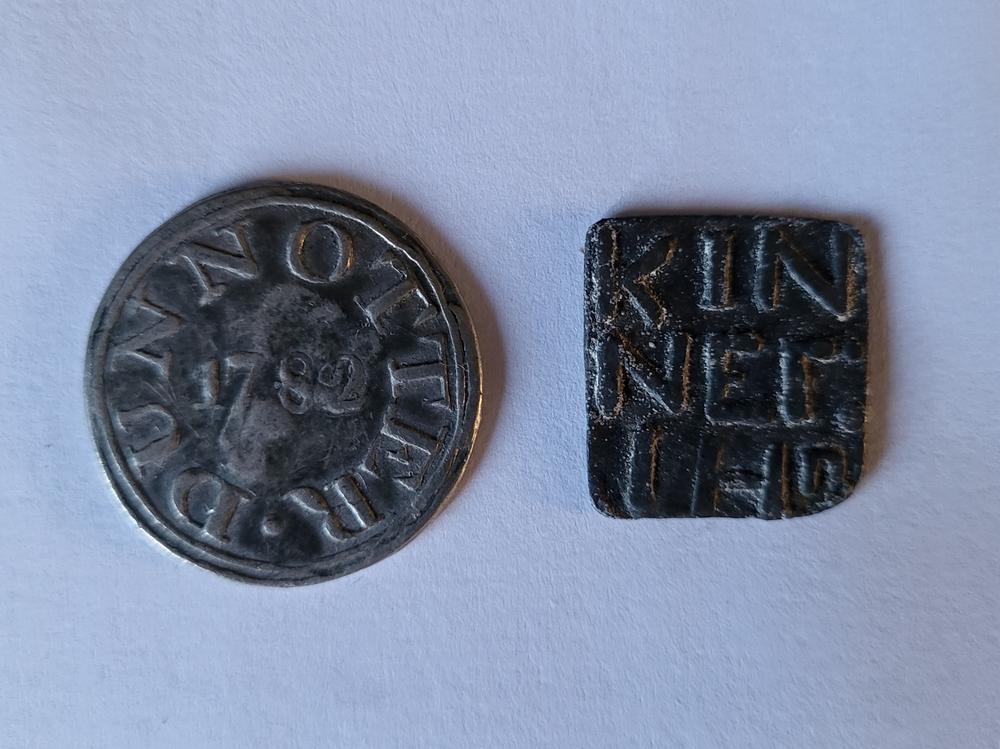Whats not to treasure - Neil Smith

When time allows, I enjoy putting on local history displays at events. This photo was taken at a vintage vehicle rally. The display focussed on Kincardineshire-born inventor of the pneumatic tyre, R W Thomson.
The Kincardineshire Association is on Facebook and Instagram
Stonehaven Tolbooth Museum is on Facebook and Instagram.
Neil G Smith is on LinkedIn.
1) Have you always collected tokens or has what you collect evolved over time?
I have always collected, from early childhood, or sorts of things. Coins and postcards were early collections, and I still add to them. Model historic vehicles were thrown into the mix too. When I lived alone I filled my flat with vintage taxidermy and other natural history specimens. Now I am married with children, most of that is now in the attic. I have always bought books, many books, although they are not a collection as such, more of a reference library about the things I collect and related subjects.
2) What influenced or inspired you to start collecting?
I would say my interest in the past. I have always been interested in history, in society, in people. The urge to collect, I think, stemmed from wanting a connection with the past. When you receive a newly circulated coin in your change in a shop, that coin may have already been held by hundreds of people. Now think about a coin from the 1600s. Where has it been? Where was it minted?
It is the same with most of my collections. I still collect postcards, although I largely keep to local images nowadays. With old postcards, sometimes the greeting is more interesting than the picture. Three or four sentences gives you a minute, candid, insight into someone’s life from the turn of the twentieth century.
I also collect medals and they are even more personal. Some were presented to those that fought, and died, in some of the toughest battles of the Great War, while others belonged to those in the supporting services, transporting munitions and so on. Others served in the Home Guard or Special Constabulary in the Second World War, and often those serving on the home front were veterans of Kitchener’s Army in the earlier conflict. To hold these medals is to hold history, and the internet has meant that they can be easily researched.

3) How long have you been collecting?
In terms of my collection of Communion Tokens, about ten years. I should, perhaps, give a brief outline as to what they are, and why I collect them.
From the time of the Reformation, John Calvin is credited with suggesting that tokens be used to determine, and identify, those in the congregation deemed worthy of the sacrament of communion. When the Presbyterian Church was recognised as the Established Church of Scotland in 1690, the Kirk openly embraced the tradition of using communion tokens. These little bits of tin and lead had the parish name, or an abbreviation, and sometimes the minister’s name, displayed. Later, as the designs became more intricate, often biblical text was added too. “This do in remembrance of me” was a common example found on many different tokens. To receive a token, and therefore be admitted to communion, one had to be of good character and possess certain knowledge of scripture. Communion tokens were in general use until the end of the 19th century, although some parishes stuck with them for many more years.
It is the social aspect of them that particularly interests me. I was born in Stonehaven, the County Town of Kincardineshire. Given that most of my ancestors, as far back as the early 17th century, came from the twenty or so parishes in the county, I have restricted my collection to Kincardineshire examples. These are the tokens that my however-many-great grandparents would have used.
It is important to remember that the period in question was a time of great religious divide and there were various breakaways from the Kirk. The Disruption of 1843, and the subsequent formation of the Free Church of Scotland, was but one of many splits and each new church that was built as a result had its own token. The Episcopalian congregations also had their own tokens. New tokens were sometimes introduced when ministers were transferred to new parishes.
4) Did you understand the process of collecting from a young age?
I did. As a child I enjoyed looking for interesting things on bric-a-brac stalls, and I loved watching the Antiques Roadshow. A little later, I started going to antiques fairs and, later still, auctions.
I don’t think anyone decides to become a collector. It is not a conscious decision, it is a natural urge. When you see something you like, you buy it. Then you buy another slightly different example. Then you buy a book about it, and realise that there are many other versions out there. And so begins another collection.
One of my auction acquaintances, himself a collector of naval artefacts, once summed collecting up as being, “a disease.” I think he was right. I even have books about collecting, and biographies of collectors!

I was baptised in Fetteresso Church fifty years ago, although, by that time, tokens had long since passed from use. My grandfather was baptised at Cookney in 1907, a church that had been built on land that belonged to our ancestors, and his grandmother at Nigg Church in 1834.
Given how little the farming community moved around, there is barely a kirk in Kincardineshire with no connection to my family.
5) Is this a lifelong road or do you think you will stop at some point - is there a goal?
In terms of Kincardineshire communion tokens there is a clear goal, and that is to complete the series. There are about 65 known examples, of which I have just over fifty. The examples that I still need are, of course, the rarer ones. They do turn up, in fact, in the last month or so I was the underbidder on three that I would have dearly loved to add to my collection. Some you win, some you lose. It is frustrating but you have to stick to your budget.
I could, perhaps, broaden the collection to take in those parishes in the neighbouring county, Aberdeenshire, where the remainder of my ancestors come from. I could also collect the tokens from the Kincardineshire-related places around the world, for communion tokens were also used in the US, Canada and Australia, to name but three countries.
There was a real craze for collecting communion tokens in the early part of the 20th century. Collections of several thousands were not uncommon among serious collectors, and a few of these superb collections found their way into public museums. I have read of men, and it generally was indeed men, with collections of seven or eight thousand examples.
6) How do you store your collection?
The tokens are kept in little sleeves, inside envelopes. The envelopes have details on the front, including parish and minister information, together with codes from the various reference books. The envelopes are themselves inside a plastic archival box. As a qualified librarian, all of my collections should be fully catalogued and carefully stored. Alas, they are not.
7) Is it displayed if that is different to storage?
They were displayed in one of my cabinets, along with some other local antiques and collectables, but as I acquired more and more examples I needed the space so I decided to file them away together with the relevant details and historical information.

8) Is the collection linked to your career or is it totally separate?
I work in retail, so my collection is totally separate. My interests in local history and culture, in archaeology, are entirely amateur. I run several local history social media pages and my collection does play a part there. Since the church was often the centre of the community, I often post about their history. Many of the church buildings in Kincardineshire are now used for other purposes, only a handful were converted as residential homes, and so they are still loved as community hubs and so on. As a trustee of the local museum, my knowledge of local historical items is always useful.
9) Do you socialise or engage with other people about your collection?
Not in person, as the field of communion token collecting is rather niche for that! I recently joined a general token collecting Facebook group, but have not posted anything on it yet. I have, as already mentioned, posted on my own Facebook page several times and the posts have been well received.
10) In the mid 20th century “swapsies” was a thing where you traded your collection - Is this still something that happens?
I think in other collecting fields this might still happen, and it would be useful, but as noted, communion tokens are rather niche so it is not something that I have come across.
11) Do you feel that collecting is a positive effect for your well being?
Without a doubt it has a positive effect. I have suffered from mild depression for most of my life, and sometimes my collecting habit has literally kept me going. When you are at your lowest, sometimes cocooning yourself with familiar objects, ones that interest or intrigue you, can help you shut out the world that is bringing you down. Having said that, it can be a very fine line between collecting and hoarding, particularly for those with more serious mental illnesses.
12) Any downsides?
Lack of space and lack of funds. You must always limit yourself to what you have room for and to what you can afford. In the old days, before covid changed everything, when I attended many auctions it was easy to get carried away. When you could see the competition, you were more likely to bid “one more time” in the hope of securing that prized object.
13) Is there an “I would love to have” or do you just add to your collection when you see something you like?
I would love to complete the Kincardineshire series of communion tokens. In terms of my other collections I buy what I like. If I see some interesting medals with a local collection, and I can afford them I will buy them. Then there is my most recent collection, local bottles, that is growing as I see them for sale.
14) Is there a specific place you collect - online, forums, markets, location?
Nowadays I tend to buy online, either directly from dealers' websites or via Ebay. Having said that, I really miss attending physical auctions. There was such a good atmosphere, and I met so many interesting people. A real sharing of knowledge went on. The main attraction was that real sense of excitement and suspense. There are still auction houses out there but the spread of online bidding has changed the whole experience. I regret that.
